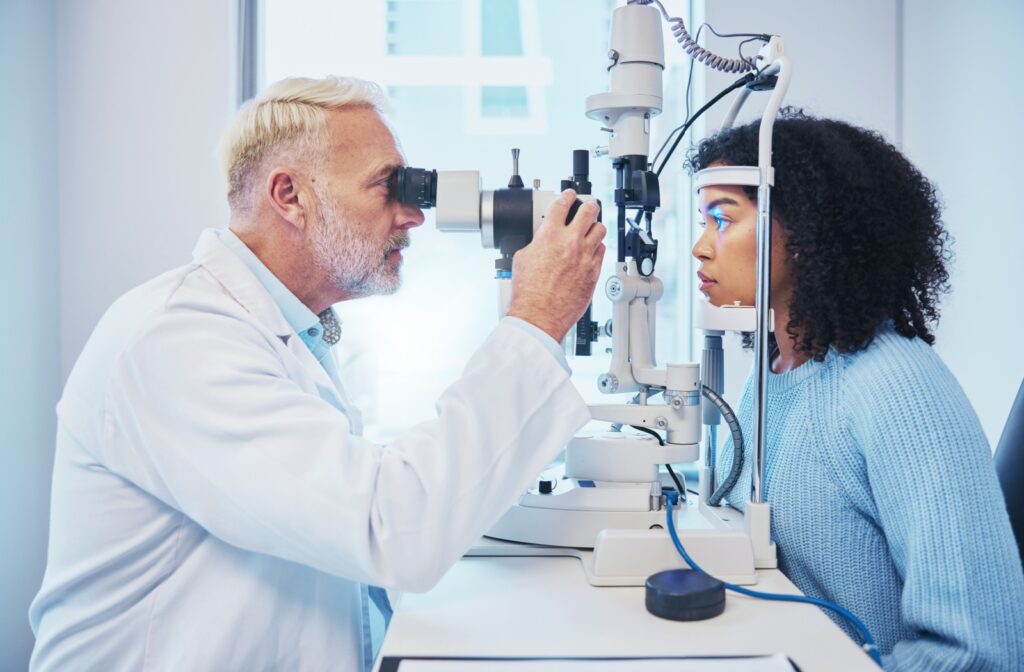If you’re dealing with a lifelong vision problem like myopia or hyperopia, you’ve likely gotten used to wearing glasses and contact lenses. But there may be a lifelong answer that offers permanent clear vision—laser eye surgery like LASIK.
LASIK is a precise procedure designed to reshape the front of your eye and restore your natural clear vision. It’s a safe and effective process that typically takes around 30 minutes per eye, making it an incredible solution to plenty of different vision problems.
What Are Refractive Errors?
To see clearly, your eye needs to work similarly to a camera. Light enters through the clear, dome-shaped cornea to pass through a lens, where it then focuses on the retina. This system relies heavily on the eye being properly shaped so that light is refracted correctly.
However, this isn’t always how the eye develops. Sometimes, it can grow too long or wide, which changes how light refracts. These are refractive errors, and they’re some of the most common vision problems.
There are 3 common refractive errors:
- Myopia, or nearsightedness, where the eye grows too long and makes distance vision poorer
- Hyperopia, or farsightedness, where the eye grows too short and makes nearby vision poorer
- Astigmatism, where the cornea or lens grows with an irregular curve, scattering light as it enters the eye to give blurry vision
These issues can easily affect almost every part of your life, and they make tasks like reading, driving, or even just relaxing and watching TV much harder. Fortunately, there’s a solution.
What Is LASIK?
LASIK stands for laser-assisted in situ keratomileusis. LASIK is an effective surgery that’s specifically designed to correct refractive errors with a special, precise laser.
This procedure is safe when performed by an experienced surgeon. During the surgery, your surgeon carefully reshapes your cornea so that it can refract light in a way that results in clear vision. Once the surgery is complete and you’ve recovered, you no longer need to rely on corrective lenses.
LASIK has a high success rate and minimal recovery time, making it a go-to solution for millions of people worldwide. However, it’s not suitable for everybody; before you’re recommended to a surgeon, you need to pass a laser eye surgery consultation to determine if this is a safe choice for you.
Who Qualifies for LASIK?
LASIK requires specific criteria to be a safe procedure. Because the surgery aims to reshape your cornea, your optometrist will need to verify that your cornea is thick enough for this procedure in the first place.
During a laser eye surgery consultation, your optometrist will need to make sure that you meet these guidelines:
- You must be over the age of 18
- Your prescription must be stable for at least 1 year
- You must have a prescription within the treatable range
- You must not be experiencing underlying eye conditions like cataracts, dry eyes, or glaucoma
- You must not be pregnant or nursing
If your optometrist thinks you’re an ideal candidate for LASIK, they’ll then measure your cornea. This lets them gain a proper understanding of how your eye needs to refract light for clear vision. They’ll also evaluate your overall eye health, after which they’ll refer you to an experienced surgeon.
If your optometrist doesn’t believe LASIK to be a safe choice for you, they’ll discuss alternative solutions to your vision issues. These can vary on a case-by-case basis.
What Happens During LASIK?
Before your procedure, you’ll receive numbing eye drops or an anesthetic. You’ll be awake throughout the procedure, so this helps keep you comfortable and relaxed while the surgeon works.
Once you’re in the exam room, a special device called a speculum is used to keep your eyelids open. Then, you can expect:
- The surgeon will create a thin, circular “flap” in the cornea using a precise laser. This flap is then folded back to access the underlying cornea.
- The surgeon uses another laser to accurately remove small amounts of corneal tissue. This reshaping allows the cornea to properly focus light onto the retina, effectively correcting the vision problem.
- Once the cornea is reshaped, the flap is carefully laid back into place. It naturally adheres without the need for stitches.
LASIK is a simple process that’s designed with your comfort in mind. Due to the eye drops, you shouldn’t feel any significant discomfort, though some people notice some mild pressure throughout the procedure. This entire surgery takes roughly 30 minutes or so, though it may vary depending on your specific situation.

What to Expect When Recovering from LASIK
After the surgery, you’ll be given protective eyewear to shield your eyes while they heal, along with antibacterial eye drops to use throughout the next few weeks to promote healing. You’ll rest for a short period before returning home. It’s important to note that you won’t be able to drive for some time after the surgery, so arrange a ride ahead of time.
During your recovery period, you may experience some dryness or grittiness. This is entirely usual, so make sure you don’t rub or scratch your eyes—this can disrupt the healing process and worsen any existing symptoms.
You’ll need to return for a few follow-up appointments over the next few months so that an experienced professional can monitor your recovery. If you notice significant pain or discomfort at any point, reach out to your optometrist.
Should You Try LASIK?
If you’re tired of dealing with glasses or contacts and want a long-term solution to improve your vision, LASIK could be the answer. At Total Vision Talega, we are here to help you make the best decision for your eye health. Contact our team to book your appointment and find out if LASIK is right for you.



